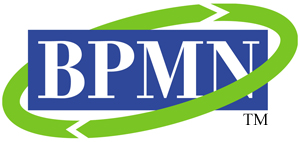Most Used Terms in BPMN
Below, you will find a selection of the most commonly used words in BPMN and their BPMN definition. If possible, that definition is compared with other framework glossaries (e.g., UML, ArchiMate, or Dragon1).
A complete list of BPMN terms can be found on the official OMG BPMN specification:

https://www.omg.org/spec/BPMN/
1. Activity
A generic term for work that a company performs in a business process.
2. Ad-Hoc Sub-Process
A subprocess in which the sequence of contained activities is not specified.
3. Artifact
Used to provide supporting information for the process, such as data or comments.
4. Association
A dotted line is used to associate information and artifacts with flow elements.
5. Business Process
A set of activities that are performed to accomplish a specific organizational goal.
6. Call Activity
A wrapper for invoking a reusable process or global task.
7. Collaboration
A BPMN diagram that shows interactions between two or more business entities (pools).
8. Compensation Event
An event used to undo or roll back the effects of a previously completed activity.
9. Conditional Event
An event that is triggered based on the evaluation of a condition.
10. Data Object
Represents data that is required or produced by activities.
11. Data Store
Provides a mechanism for activities to retrieve or persist data.
12. End Event
Indicates the end of a process path.
13. Event
Something that happens during the course of a process, affecting its flow.
14. Event Sub-Process
A subprocess triggered by an event rather than a sequence flow.
15. Exclusive Gateway
Used to create alternative paths in a process; only one path is taken.
16. Inclusive Gateway
Allows multiple paths to be taken if conditions are met.
17. Intermediate Event
An event that occurs between the start and end of a process.
18. Lane
A partition within a pool representing a role or function.
19. Looping
Repeats an activity until a specified condition is met.
20. Manual Task
A task performed without any aid from a business process execution engine.
21. Message Flow
Shows the flow of messages between separate process participants.
22. Parallel Gateway
Splits the flow into multiple parallel paths or joins them.
23. Participant (Pool)
Represents a specific business entity or participant in the process.
24. Process
A sequence of activities designed to produce a specific result.
25. Script Task
A task executed by a business process engine using a script.
26. Service Task
A task that uses a web or automated service to perform an activity.
27. Signal Event
Indicates a broadcast event within or across processes.
28. Start Event
Marks the beginning of a process or sub-process.
29. Sub-Process
A compound activity that contains its own flow of tasks, events, and gateways.
30. User Task
A task that requires human interaction through a user interface.
31. Error Event
Indicates an error in a process and allows exception handling.
32. Escalation Event
Used to indicate the need for higher-level attention or action.
33. Boundary Event
An event attached to the boundary of an activity, typically for exceptions or interrupts.
34. Cancel Event
Used to model the cancellation of a transaction sub-process.
35. Timer Event
Triggered by a specific time or cycle condition.
36. Link Event
Used to create a virtual connection between two process sections.
37. Terminate End Event
Ends all process activities immediately.
38. Text Annotation
A way to add additional descriptive text to elements in a BPMN diagram.
39. Flow Object
Core elements used in process modeling: events, activities, and gateways.
40. Gateway
Used to control the divergence and convergence of sequence flows.
41. Sequence Flow
Shows the order in which activities are performed in a process.
42. Pool
Represents a participant or major component in a BPMN Collaboration.
43. Event-Based Gateway
A decision point where the chosen path depends on which event occurs first.
44. Transaction
A type of sub-process where all contained activities must be completed successfully.
45. Compensation
An activity used to reverse the outcome of previously completed actions.
46. Conditional Flow
A sequence flow only occurs if a certain condition is true.
47. Default Flow
A flow is taken when none of the other conditions are met.
48. Multiple Instance Task
A task that runs multiple times, either in parallel or sequentially.
49. Signal
A mechanism to broadcast or receive events across process boundaries.
50. Interface
Defines a set of operations a participant offers or requires.